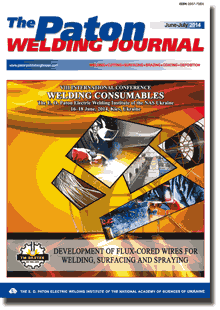| 2014 №06 (30) |
DOI of Article 10.15407/tpwj2014.06.31 |
2014 №06 (32) |

The Paton Welding Journal, 2014, #6-7, 143-146 pages
INVESTIGATION OF TRANSITION ZONE OF LOW-CARBON STEEL JOINT WITH HIGH-ALLOYED Cr-Ni DEPOSITED METAL
K.A. YUSHCHENKO, Yu.N. KAKHOVSKY, A.V. BULAT, R.I. MOROZOVA, A.V. ZVYAGINTSEVA, V.I. SAMOJLENKO and Yu.V. OLEJNIK
E.O. Paton Electric Welding Institute, NASU. 11 Bozhenko Str., 03680, Kiev, Ukraine. E-mail: office@paton.kiev.ua
Abstract
Causes for fracture of repair layer deposited with electrodes of E-08Kh20N9G2B type on the surface of St3sp (killed) steel lining of water wheel chamber of HPS hydraulic unit are analyzed. It is established that its failures (cracking, delamination) arise as a result of lower chromium content (less than 12 %) and formation of martensite phase in the transition zone between steel St3sp and high-alloyed deposited metal. State of transition zone between St3sp and deposited metal of E-10Kh25N13G2, E-11Kh15N25M6AG2 and 10Kh28N14G2 type at welding current variation in the range of 80-140 A has been studied. It is shown that sufficient content of chromium (less than 12 %) and absence of martensite in the transition zone can be ensured in the case of application of electrodes of 10Kh28N14G2 type for repair surfacing at limitation of Iw to not more than 90 A. 6 Ref., 5 Figures, 1 Table.
Keywords: coated-electrode manual arc welding, low-carbon steel, high-alloyed deposited metal, transition zone, structural and chemical inhomogeneity, martensite, microhardness, cracks, corrosion
Received: 24.03.14
Published: 28.09.14
References
1. Gotalsky, Yu.N. (1981) Welding of dissimilar steels. Kiev: Tekhnika.
2. Zemzin, V.N. (1966) Welded joints of dissimilar steels. Moscow: Mashinostroenie.
3. Lebedev, V.K., Kuchuk-Yatsenko, S.I., Chvertko, A.I. et al. (2006) Machine-building: Encyclopedia. Vol.III-4: Technology of welding, brazing and cutting. Moscow: Mashinostroenie.
4. Elagin, V.P., Gordan, G.N. (2013) To mechanism of lowering of chemical and structural heterogeneity in fusion zone of austenitic weld with carbon steel. In: Abstr. of Int. Conf. on Welding and Related Technologies - Present and Future (Kiev, 2013), 70.
5. Babakov, A.A., Pridantsev, M.V. (1971) Corrosion-resistant steels and alloys. Moscow: Metallurgiya.
6. Pavlov, I.V., Antonets, D.P., Gotalsky, Yu.N. (1980) To problem of mechanism of transition layer formation in fusion zone of dissimilar steels. Avtomatich. Svarka, 7, 5-7.
